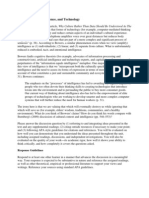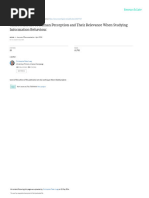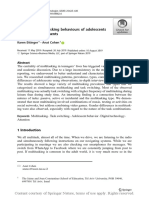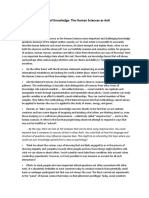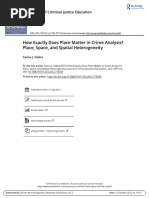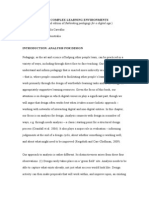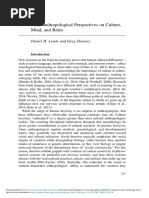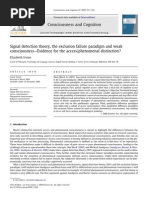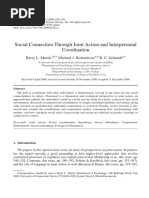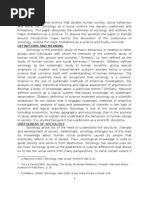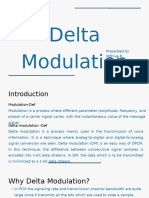0 ratings0% found this document useful (0 votes)
113 viewstmpD55E TMP
tmpD55E TMP
Uploaded by
FrontiersThis document discusses how embodied interaction with architectural space is more complex than traditionally understood in information science. It notes that subjects in wayfinding experiments often failed to notice relevant information due to factors like body orientation and perception issues. A coherent theory of embodied information behavior is needed that incorporates insights from fields like information science, psychology, biology and neuroscience. Collecting data through traditional means like questionnaires and interviews is limited as it relies on subjects' abilities to recall and introspect accurately on their experiences. Understanding individual perception of space requires analyzing moment-to-moment embodied interaction, not just reported data.
Copyright:
© All Rights Reserved
Available Formats
Download as PDF, TXT or read online from Scribd
tmpD55E TMP
tmpD55E TMP
Uploaded by
Frontiers0 ratings0% found this document useful (0 votes)
113 views4 pagesThis document discusses how embodied interaction with architectural space is more complex than traditionally understood in information science. It notes that subjects in wayfinding experiments often failed to notice relevant information due to factors like body orientation and perception issues. A coherent theory of embodied information behavior is needed that incorporates insights from fields like information science, psychology, biology and neuroscience. Collecting data through traditional means like questionnaires and interviews is limited as it relies on subjects' abilities to recall and introspect accurately on their experiences. Understanding individual perception of space requires analyzing moment-to-moment embodied interaction, not just reported data.
Original Title
tmpD55E.tmp
Copyright
© © All Rights Reserved
Available Formats
PDF, TXT or read online from Scribd
Share this document
Did you find this document useful?
Is this content inappropriate?
This document discusses how embodied interaction with architectural space is more complex than traditionally understood in information science. It notes that subjects in wayfinding experiments often failed to notice relevant information due to factors like body orientation and perception issues. A coherent theory of embodied information behavior is needed that incorporates insights from fields like information science, psychology, biology and neuroscience. Collecting data through traditional means like questionnaires and interviews is limited as it relies on subjects' abilities to recall and introspect accurately on their experiences. Understanding individual perception of space requires analyzing moment-to-moment embodied interaction, not just reported data.
Copyright:
© All Rights Reserved
Available Formats
Download as PDF, TXT or read online from Scribd
Download as pdf or txt
0 ratings0% found this document useful (0 votes)
113 views4 pagestmpD55E TMP
tmpD55E TMP
Uploaded by
FrontiersThis document discusses how embodied interaction with architectural space is more complex than traditionally understood in information science. It notes that subjects in wayfinding experiments often failed to notice relevant information due to factors like body orientation and perception issues. A coherent theory of embodied information behavior is needed that incorporates insights from fields like information science, psychology, biology and neuroscience. Collecting data through traditional means like questionnaires and interviews is limited as it relies on subjects' abilities to recall and introspect accurately on their experiences. Understanding individual perception of space requires analyzing moment-to-moment embodied interaction, not just reported data.
Copyright:
© All Rights Reserved
Available Formats
Download as PDF, TXT or read online from Scribd
Download as pdf or txt
You are on page 1of 4
Quo Vadis?
Embodied Interaction with Architectural Space1
Christopher P. Lueg
Information & Interaction (i2) Research Group
University of Tasmania
Hobart, TAS, Australia
christopher.lueg@utas.edu.au
ABSTRACT
When conducting in situ wayfinding experiments we
observed that for a variety of reasons, subjects failed to
consider information that was relevant to the navigation
task at hand even though that information appeared to be
readily available. Likely reasons for the failure to notice
include location of the subject, the orientation of the
subject's body relative to relevant information, as well as a
range of issues related to both physiology and psychology
of perception. Drawing from a body of literature on
understanding and modelling human information behaviour
in information science we note that as yet there is no
coherent theory of information behaviour being an
embodied activity. Building such a theory will require
substantial, cross-disciplinary efforts linking work across
information
science,
psychology,
biology,
and
neuroscience, to name a few.
Author Keywords
Interaction, information behaviour; perception;
embodiment.
ACM Classification Keywords
H.5.m. Information interfaces and presentation (e.g., HCI):
Miscellaneous.
INTRODUCTION
Moving around in physical and increasingly also in virtual
environments, checking for information (such as landmarks
in the case of wayfinding) and making decisions on how to
proceed along the way is a core aspect of the human
existence. Conroy (2001, p. 26) defines wayfinding as "the
act of travelling to a destination by a continuous, recursive
process of making route-choices whilst evaluating previous
spatial decisions against constant cognition of the
environment."
The discipline of information science has a long history of
being interested in understanding and modeling information
behaviour, especially information behaviour situated in
built environments and with particular emphasis on office
and library environments. Interest in understanding and
modelling human information behaviour is shared across a
range of disciplines including marketing and architecture
since understanding the way we perceive our environment
is increasingly considered key to delivering successful
outcomes, such as sales and liveability, respectively. As yet
the overlap between the disciplines is limited but growing.
Elsewhere we have pointed out that findings in allied
disciplines regarding the specific characteristics of human
perception suggest to rethink the way we conceptualize
information behaviour in information science (Lueg 2013),
and we argue that this shift may also be useful when
investigating interaction with architectural space.
In particular, we argue that in order to fully understand
human behaviour in natural and constructed spaces we need
to consider behaviour and cognition as an inter-dependent,
emergent, and embodied phenomenon.
Rakova (2006) defines embodiment as "the fact that we are
not pure minds but minds embedded in bodies". The point is
that it is now widely recognized that having an [active]
body is not only required for perceiving (Merleau-Ponty
1962; Gibson 1986) and interacting with the world but
embodiment has also has a crucial role in enabling
intelligent behaviour (e.g., Clark, 1997; Wilson, 2002;
Gallagher, 2005; Pfeifer and Bongard, 2007).
The crux is that knowing about embodiment and its
relevance is one thing but paying attention to the fact in
experimental setups is another. The fact that a coherent
theory of behaviour being an embodied activity is yet to be
developed adds to the pain, especially since developing one
would require substantial, cross-disciplinary efforts linking
research across information science, anthropology,
sociology, psychology, biology, neuroscience, and
philosophy, to name a few.
There is also an unfortunate tendency to treat embodiment
as a somewhat trivial issue. After all, all humans have a
body ("every'body'"). A closer look, however, reveals that
accounting for embodiment and its characteristics makes
understanding behaviour a formidable challenge.
Draft accepted at the CHI 2014 Workshop "Interaction and Architectural Space". Toronto, Canada, 26-27 April 2014.
PEOPLE ARE DIFFERENT
Simply put, no two human bodies are exactly the same
which means that the world looks and feels different to each
of those individuals. Mentioning that we have bodies of
different weight and height, that we move at different
speeds and gaits, and that our hearing and eyesight may
vary considerably appears to be trivial but it is not once we
take into consideration that those individual characteristics
impact on how we perceive the world. Body height directly
influences what we can easily perceive and grab
(supermarket shelves are stocked accordingly) and so does
eyesight and, to some extent, hearing.
To some extent we are aware that our mood affects what we
pay attention to and that our bodily condition affects how
we perceive our surroundings. There is a reason as to why
people should avoid doing their grocery shopping when
they feel hungry (e.g., Malik et al 2008).
'obvious': thought processes and the body's motion are
linked in ways that researchers are only beginning to
understand (see e.g., Taylor et al 2009). See also Keilty's
(2012) discussion of factors such as "anxiety, desire,
leisure, pleasure, boredom, frustration, uncertainty,
curiosity, serendipity, surprise, anticipation, immersion,
sense-making or cognition, habits, and memory, among
others".
To sum up, it is fair to say that the surrounding environment
looks and feels differently to every individual, which in turn
affects to some extent how they think and goes well beyond
'situational factors' (e.g., Barry 1994) that affect
information behaviors.
The statement holds true even without taking into
consideration identified conditions that affect what might
be called neurotypical (Dalton 2013) or conditions
including colour vision deficiencies (the often used 'colour
blindness' is a misnomer since people affected by the
condition do see colours they just see them differently).
These considerations may offer yet another approach to
explaining as to why people get lost in buildings, in
addition to the three contributing factors the spatial
structure of the building, the cognitive maps that users
construct as they navigate, and the strategies and spatial
abilities of the building users (Carlson et al 2010).
To be sure we do not claim that there are no similarities and
statistical patterns in the way people perceive their
surroundings. Without sharing these similarities we would
find it hard to form societies, conduct trade, drive cars, and
so on. It does mean however that if we really want to know
how people experience architectural space we need to
understand how individuals perceive the space as opposed
to how 'most' people perceive the space.
COLLECTING DATA: "IT'S A TRAP"
Figure 1 Anar Foundation Against Child Abuse display
leveraging differences in height and therefore perspective
The tasks that we work on or that plays on our minds also
affect what we pay attention to: "Our eye movements are
not driven by what is biggest, brightest, or flashiest in a
visual scene. They reflect the purpose of our looking."
(Ellard, 2009). Rothkopf et al. (2007) state more formally
"[...] in the execution of extended natural tasks, human
gaze is directed toward regions of the visual scene that are
determined primarily by the task requirements." This
doesn't mean that we don't pay attention to visually noisy
aspects in the environment just that they do not necessarily
drive what we pay attention to.
Most people would be unaware that the way we move has
an impact on how we perceive the world beyond the
In Lueg (2013) we presented a first overview of the
different types of information we are exposed to, some of
which we are able to perceive. We also relate a number of
cognitive phenomena, such as inattentional blindness
(Mack and Rock, 1998) or platonic blindness (Dunham and
Banaji 2010), to how different people perceive their
environment. Research regarding these cognitive
phenomena indicates that even if a subject 'looks' into a
certain direction that does not mean that the information is
consciously perceived, which makes analysing their
experience rather difficult. These cognitive characteristics
have evolved to help humans cope with continuous
information overload (Lueg and Pfeifer 1997) which means
they need to be seen as both strengths and weaknesses:
"[inattentional blindness] is the price we pay for the gift of
attention." (Green, 2011).
Understanding how individuals perceive a space is a nontrivial task especially since many approaches, including
those commonly used in information, heavily rely on
reported data, typically collected via interviews,
questionnaires, or "thinking aloud" sessions. In Lueg (2013)
we question that approach to analysing and modelling
information behaviour on the grounds that what we call
'positive' data offers limited insights into what information
a subject failed to notice (means they can't report on it), and
typically no insights as to why they failed to do so.
Furthermore, human capacity for introspection is limited
(Nisbett and Wilson 1977) which means that even if
subjects do report what they believe they noticed, the
explanations may be post-hoc rationalizations (i.e.,
explanations that make sense to the subject but don't
necessarily represent what happened).
A related that we encountered in wayfinding research is that
post experiment questionnaires (e.g., "which landmarks did
you use?") test recall, i.e., a person's memory capacity, not
necessarilyas intendedsaliency of landmarks (Bidwell
et al. 2005).
The challenge is still to analyse moment-to-moment,
embodied interaction with the environment, including other
people: "The basic unit of analysis must connect thinking to
action in the world and contribute to clarifying precisely
how cognition enters into and is part of the diverse set of
tasks in which people engage. Furthermore, because
virtually all activity is socially distributed, social units
rather than individuals become the appropriate unit of
analysis for cognition." (Resnick et al., 1997). The effort
required for doing so, however, is tremendous. As
discussed in Lueg (2013), complementing traditional
qualitative data collection methods with ethnographic
methods, such as participant observation combined with
third party "ideal observer" analyses of the situation at
hand, would address some of the issues but the additional
effort is high and accuracy typically low (e.g., gaze
direction). Furthermore, as mentioned earlier, inattentional
blindness and other cognitive characteristics suggest even if
a subject looks into a certain direction that does not mean
that the information is consciously perceived and 'actioned'.
COLLECTING ADDITIONAL 'EVIDENCE'
There are a number of ways how technology can assist with
collecting data about interaction with architectural space,
among them
Gaze-tracking
When Barry (1994) and others interested in situational
factors in information behaviour conducted their
experiments they had to do so largely without tracking
technologies that are available these days. Few information
science researchers have employed eye tracking techniques
to this date. Realising the potential, Erdelez (2004)
proposed to use the technology to explore "noticing" in
information encountering using subjects sitting in front of
computers. Balatsoukas and Ruthven (2012) also used
stationary setups when exploring relevance assessments. In
the area of ubiquitous computing, Bulling et al. (2011)
identified characteristic patterns in eye movements that can
be used to identify certain types of tasks, such as reading,
that subjects are working on while their gaze is being
tracked.
Gaze tracking is frequently used in studies of consumer
behaviour (e.g., Shayon 2012) which is an area that is
highly relevant to information behaviour research and
studying interaction with architectural space: knowing in
great detail as to what people look at (and potentially pay
attention to) but also what information they do not pay
attention to will allow to ground behavioral models in
richer data than is currently available. Psychophysiological
measurements could be used to complement the data (e.g.,
Nacke et al 2010).
Virtual reality environments
Using virtual reality environments for researching
interaction with architectural space has become popular.
One reason is that environments can be tested without
having to build them in the real work. Another that "[i]n a
virtual environment [...] the creator of the world (or the
designer of the experiment) knows precisely what
components went into the creation that world. A researcher
using a virtual test-environment can be confident that the
world will consist of only those factors that the researcher
has chosen to include in the world. [...] Variables being
investigated (for their effect) can be examined by including
or altering only those variables in the world." (Conroy
2001, p. 17; see also Zimring and Conroy-Dalton 2003).
An issue is that cognition understood as an embodied
phenomenon means that when people "feel" differently
while navigating virtual reality environments, their
perception will be different too. It would be fascinating to
know the nature of those differences and how exactly they
impact on perception. Consumer research esp. marketing
developed a bag full of tricks (background music, smell,
special lighting, tables as 'stoppers', tables that afford
grabbing, etc.) to influence shopper perception and
associated buying behaviours.
CONCLUSION
Accepting that perception is an embodied phenomenon
suggests that understanding interaction with architectural
space is a multi-disciplinary challenge ranging from more
formal aspects like design patterns and space syntax to the
specific characteristics of human behaviour and cognition.
If we need to clarify precisely how cognition enters into
and is part of the diverse set of tasks in which people
engage to understand interaction with architectural space
(which we argue for) then we need to develop a broader set
of data collection and interpretation methods to tackle the
challenge.
We believe there is much to gain in looking 'over the fence'
from architecture to information science, and vice versa.
For example, Gibson's (1986) theory of affordances which
frequently used to explain how people navigate spaces was
used by Sadler and Given (2007) to understand how
students perceive and use the various opportunities for
action (books, databases, instructional sessions, librarians,
physical space, etc.) offered by the local library and how
these perceived affordances matched librarians intentions
and expectations.
ACKNOWLEDGMENTS
tba
REFERENCES
Keilty, P. (2012), "Embodiment and desire in browsing
online pornography", Proc. i-Conference, Toronto, Canada,
pp. 4147.
Lueg, C. (2013). Characteristics of human perception and
their relevance when studying information behavior.
Journal of Documentation, Emerald, to appear.
Lueg, C. and Pfeifer, R. (1997), "Cognition, situatedness,
and situated design", Proc. 2nd International Conference
on Cognitive Technology (CT 97), IEEE Press, Aizu, Japan,
August 25 28, pp. 124135.
Balatsoukas, P. and Ruthven, I. (2012), "An eye-tracking
approach to the analysis of relevance judgments on the
Web: The case of Google search engine", Journal of the
American Society for Information Science and Technology
63 (9) pp. 17281746.
Mack, A. and Rock, I. (1998). Inattentional Blindness. MIT
Press.
Barry, C. (1994), "User-defined relevance criteria: an
exploratory study", Journal of the American Society for
Information Science, 45(3) pp. 149159.
Merleau-Ponty, M. (1962). Phenomenology of perception
English edition first published in 1962 (C. Smith, Trans.).
London: Routledge and Kegan Paul. Routledge Classics.
Bidwell, N., Lueg, C., and Axup, J. (2005). The territory is
the map: designing navigational aids. Proc. CHI-NZ. ACM,
New York, NY, USA, pp. 91-100.
Nacke, L. E., Grimshaw, M. N., Lindley, C. A. 2010.
"More Than a Feeling: Measurement of Sonic User
Experience and Psychophysiology in a First-Person Shooter
Game". Interacting with Computers, vol. 22.
Carlson, LA; Hlscher, C; Shipley, TF; Conroy Dalton, R;
(2010) Getting lost in buildings. Current Directions in
Psychological Science , 19 (5) 284 - 289.
Clark, A. (1997). Being There. Putting Brain, Body, and
World Together Again. MIT Press. Cambridge, MA. A
Bradford Book.
Conroy, R. (2001), "Spatial Navigation in Immersive
Virtual Environments", PhD thesis, The Faculty of the Built
Environment, Department of Architecture, University
College London, UK.
Malik S, McGlone F, Dagher A. Ghrelin Modulates the
Hedonic Value of Visual Food Stimuli: A fMRI Study in
Humans. Cell Metabolism 2008 7(5):400-9.
Nisbett, R. E. and Wilson, T. D. (1977). Telling more than
we can know: Verbal reports on mental processes.
Psychological Review, 84(3):231259.
Pfeifer, R. and Bongard, J. (2007). How the Body Shapes
the Way We Think: A New View of Intelligence. MIT Press,
Cambridge, MA.
Rakova, M. (2006). Philosophy of Mind AZ, University of
Edinburgh Press.
Dalton, Nick S. (2013). Neurodiversity HCI. interactions,
20(2), pp. 7275.
Rothkopf, C. A., Ballard, D. H., and Hayhoe, M. M. (2007),
"Task and context determine where you look", Journal of
Vision, 7(14):16, pp. 120.
Dunham, Y. and Banaji, M. (2010), "Platonic blindness and
the challenge of understanding context", Mesquita, B.,
Feldman Barrett, L., and Smith, E. R. The Mind in Context.
The Guilford Press.
Sadler, E. and Given, L. M. (2007), "Affordance theory: A
framework for graduate students' information behaviors",
Journal of Documentation, 63, no.1, pp. 115-141. Emerald.
Erdelez, S. (2004). Investigation of information
encountering in the controlled research environment.
Information Processing & Management 40, pp. 1013-1025.
Erdelez, S., Miwa, M., Lund, H. and Gwizdka, J. (2009).
What Can Eye-Trackers Visualize? An Approach to
Capture the Reality of Search Processes (panel). Proc.
ASIS&T. Wiley.
Gallagher, S. (2005). How the Body Shapes the Mind.
Oxford University Press.
Gibson, J. J. (1986). The ecological approach to visual
perception. Hillsdale, NJ: Erlbaum. (orig publ in 1979).
Shayon, S. (2012). Eye-Tracking Helping Marketers Boost
Shelf Awareness. http://www.brandchannel.com/home/
post/2012/07/17/eye-tracking-cpg-071712.aspx
Taylor CA, Lord CG, Bond CF Jr. (2009). Embodiment,
agency, and attitude change. J Pers Soc Psychol. 2009 Dec;
97(6):946-62. doi: 10.1037/a0017421.
Wilson, M. (2002), "Six views of embodied cognition",
Psychonomic Bulletin & Review 9 (4), pp. 625636.
Zimring, C. and Conroy Dalton, R. (2003). Linking
Objective Measures Of Space To Cognition and Action.
Environment and Behavior 35; 3.
You might also like
- Libro Destroza Este DiarioDocument129 pagesLibro Destroza Este DiarioDaniela60% (5)
- U10d2 CultureDocument4 pagesU10d2 Culturearhodes7770% (1)
- Art Collins, Robert Pardo - Beating The Financial Futures Market - Combining Small Biases Into Powerful Money Making StrategiesDocument272 pagesArt Collins, Robert Pardo - Beating The Financial Futures Market - Combining Small Biases Into Powerful Money Making Strategiesmaheshmuralinair6100% (3)
- ExMagic Final AcceptedDocument20 pagesExMagic Final AcceptedAisyah SeptiaNo ratings yet
- The Endof Average Todd Rose 2016Document5 pagesThe Endof Average Todd Rose 2016Bahadır AykınNo ratings yet
- Glenberg 2015 Embodiment CognitionDocument7 pagesGlenberg 2015 Embodiment CognitionVictoria Paz Larraín SánchezNo ratings yet
- Cognitive Bases of Human Creativity: Educ Psychol Rev DOI 10.1007/s10648-008-9091-6Document9 pagesCognitive Bases of Human Creativity: Educ Psychol Rev DOI 10.1007/s10648-008-9091-6Ioana RidelNo ratings yet
- Grounding Cognition in Action ExpertiseDocument9 pagesGrounding Cognition in Action ExpertiseDenis LordanNo ratings yet
- ReflexivityReflexivity The New Reflective by Glynn CousinDocument5 pagesReflexivityReflexivity The New Reflective by Glynn CousinBigolo1960No ratings yet
- W10 Kiverstein (2017) - The Routledge Handbook of Philosophy of The Social MindDocument19 pagesW10 Kiverstein (2017) - The Routledge Handbook of Philosophy of The Social MindCyrus HsuNo ratings yet
- Patterns of Multitasking Behaviours of AdolescentsDocument24 pagesPatterns of Multitasking Behaviours of AdolescentsMisha Hdez LozanoNo ratings yet
- WERSIG, Gernot. Information Science Needs A Theory of Information ActionsDocument13 pagesWERSIG, Gernot. Information Science Needs A Theory of Information ActionsAnonymous QMFYEGcfZ7No ratings yet
- Thinking Through The Implications of Embodiment.s. Fergus AndersonDocument13 pagesThinking Through The Implications of Embodiment.s. Fergus AndersonRenata KroeffNo ratings yet
- The Human SciencesDocument5 pagesThe Human SciencesKayeNo ratings yet
- Introduction- Definition, Brief History, and Taxonomy of Individual DifferencesDocument6 pagesIntroduction- Definition, Brief History, and Taxonomy of Individual Differencessibariwalid21No ratings yet
- Sweller 2004Document24 pagesSweller 2004Yoliset RomeroNo ratings yet
- V3N1P1-2019 Owijoppa1Document14 pagesV3N1P1-2019 Owijoppa1Frexxe IDNo ratings yet
- CR Review Js 1Document9 pagesCR Review Js 1api-254084898No ratings yet
- Within-person_structures_of_daily_cognitive_perforDocument28 pagesWithin-person_structures_of_daily_cognitive_perforanabel.garcia.generalNo ratings yet
- How Exactly Does Place Matter in Crime Analysis? Place, Space and Spatial HeterogeneityDocument27 pagesHow Exactly Does Place Matter in Crime Analysis? Place, Space and Spatial HeterogeneityMa Fer NietoNo ratings yet
- Visual Attention and Its Intimate Links to Spatial CognitionDocument10 pagesVisual Attention and Its Intimate Links to Spatial Cognitionelectro-ub ubNo ratings yet
- Okojie 7Document18 pagesOkojie 7Chingenyim Valentine AkaaghoNo ratings yet
- CR Review FinalDocument9 pagesCR Review Finalapi-254084898No ratings yet
- Analisis of Lean Construction PracticesDocument10 pagesAnalisis of Lean Construction PracticesvictorNo ratings yet
- tmp935 TMPDocument13 pagestmp935 TMPFrontiersNo ratings yet
- 2016 - Delli Et Al. - Application of The Theory of Mind, Theory of Executive Functions and Weak Central Coherence Theory To Individuals With ASDDocument22 pages2016 - Delli Et Al. - Application of The Theory of Mind, Theory of Executive Functions and Weak Central Coherence Theory To Individuals With ASDleo410257005No ratings yet
- Desertification EssayDocument7 pagesDesertification Essaygejjavbaf100% (2)
- 2020 - Barsalou Borghi - Barsalou-Psychological - Research-Perspective - ConceptualizationDocument23 pages2020 - Barsalou Borghi - Barsalou-Psychological - Research-Perspective - ConceptualizationGerson JohanNo ratings yet
- The Analysis of Complex Learning EnvironmentsDocument24 pagesThe Analysis of Complex Learning Environmentspablor127100% (1)
- DcogfriendDocument19 pagesDcogfriendwomenpsychologymasteryNo ratings yet
- Material Knowing: The Scaffolding of Human KnowledgeabilityDocument14 pagesMaterial Knowing: The Scaffolding of Human Knowledgeabilityyz2104382No ratings yet
- Bates-Fundamental Forms of InformationDocument13 pagesBates-Fundamental Forms of InformationthosampaNo ratings yet
- Chapter 2Document16 pagesChapter 2KeerthanKpNo ratings yet
- Human AspirationDocument21 pagesHuman Aspirationchikakai11No ratings yet
- Why Evolved Cognition Matters To Understanding Cultural Cognitive VariationsDocument12 pagesWhy Evolved Cognition Matters To Understanding Cultural Cognitive VariationsJenny sunNo ratings yet
- Barsalou - 2020 - GROUNDED COGNITIONDocument24 pagesBarsalou - 2020 - GROUNDED COGNITIONДарья БарашеваNo ratings yet
- Aesthetic Preferences For Prototypical Movements in Human ActionsDocument13 pagesAesthetic Preferences For Prototypical Movements in Human ActionsAndrésNo ratings yet
- Intelligence PsychDocument8 pagesIntelligence PsychMitch SabioNo ratings yet
- Sex VisionDocument26 pagesSex Visionbigbigbig90003270No ratings yet
- NeuroanthropologyDocument23 pagesNeuroanthropologykarthikaanilkumar5420No ratings yet
- Research As Relational Practice - McNameeDocument21 pagesResearch As Relational Practice - McNameeAndrésFelipeMaldonadoGiratá100% (1)
- DimensionsofmindDocument19 pagesDimensionsofmind050903tthNo ratings yet
- International Encyclopedia of The Social and BehavDocument14 pagesInternational Encyclopedia of The Social and Behavjuan diego echeverry plazasNo ratings yet
- Levine, Resnick & Higgins, 1993. Social Foundations of Cognition SummaryDocument1 pageLevine, Resnick & Higgins, 1993. Social Foundations of Cognition SummaryImanNo ratings yet
- Etnografi Media Tom BoellstorffDocument5 pagesEtnografi Media Tom BoellstorffRias TianaNo ratings yet
- Irvine 2009 Signal Detection Theory, The Exclusion Failure Paradigm and Weak Consciousness-Evidence For The Accessphenomenal DistinctionDocument10 pagesIrvine 2009 Signal Detection Theory, The Exclusion Failure Paradigm and Weak Consciousness-Evidence For The Accessphenomenal DistinctionhoorieNo ratings yet
- Spatial BehaviourDocument7 pagesSpatial Behaviourmantripatgrewal35No ratings yet
- Unit 3 - AspDocument23 pagesUnit 3 - Aspvaibhavi BarkaNo ratings yet
- A j.1756-8765.2009.01022.x PDFDocument20 pagesA j.1756-8765.2009.01022.x PDFFábio SagginNo ratings yet
- New Wave Theories of Cognition - IDocument40 pagesNew Wave Theories of Cognition - IJCNo ratings yet
- Moods, Emotions and Creative Thinking: A Framework For TeachingDocument11 pagesMoods, Emotions and Creative Thinking: A Framework For TeachingWahyu PratamaNo ratings yet
- The Education of PerceptionDocument20 pagesThe Education of PerceptionAsep SuhermanNo ratings yet
- Allen 2011Document13 pagesAllen 2011Victor Ricardo Ruiz LlamasNo ratings yet
- Social Adaptation ThesisDocument6 pagesSocial Adaptation ThesisAshley Hernandez100% (2)
- Conversation Analysis: 1. Learning ObjectivesDocument53 pagesConversation Analysis: 1. Learning Objectiveselvira lindaNo ratings yet
- The Contribution of Cognitive Psychology To The STDocument18 pagesThe Contribution of Cognitive Psychology To The STAshutosh SrivastavaNo ratings yet
- Sociology PaperDocument7 pagesSociology PapermwambadakaNo ratings yet
- Hypothesis TestingDocument34 pagesHypothesis TestingNova Sedana YogaNo ratings yet
- CH 7 Factors That Influence Communiction Draftv2Document44 pagesCH 7 Factors That Influence Communiction Draftv2Freddy Orlando MeloNo ratings yet
- Imagination and Memory ExperimentDocument7 pagesImagination and Memory Experimentkennedy kimweliNo ratings yet
- tmpF178 TMPDocument15 pagestmpF178 TMPFrontiersNo ratings yet
- Tmp1a96 TMPDocument80 pagesTmp1a96 TMPFrontiersNo ratings yet
- tmp998 TMPDocument9 pagestmp998 TMPFrontiersNo ratings yet
- tmpE3C0 TMPDocument17 pagestmpE3C0 TMPFrontiersNo ratings yet
- Tmp75a7 TMPDocument8 pagesTmp75a7 TMPFrontiersNo ratings yet
- tmp3656 TMPDocument14 pagestmp3656 TMPFrontiersNo ratings yet
- tmpA7D0 TMPDocument9 pagestmpA7D0 TMPFrontiersNo ratings yet
- tmp96F2 TMPDocument4 pagestmp96F2 TMPFrontiersNo ratings yet
- tmp97C8 TMPDocument9 pagestmp97C8 TMPFrontiersNo ratings yet
- Modicon M340 - BMXP342020Document4 pagesModicon M340 - BMXP342020Marcio MuracaNo ratings yet
- Avigilon H5a Dual Head Camera Datasheet enDocument7 pagesAvigilon H5a Dual Head Camera Datasheet ensales.datamagnetNo ratings yet
- Empowerment Technology - Internet ThreatsDocument17 pagesEmpowerment Technology - Internet ThreatsMac-mac PusaNo ratings yet
- TRAX UG en V02bDocument48 pagesTRAX UG en V02bMilton J. HernandezNo ratings yet
- Muslim Manners: The Little Book ofDocument57 pagesMuslim Manners: The Little Book offirdausaharmsNo ratings yet
- T3IBSAL - InclusiveBankingSuite Lending OperationsDocument110 pagesT3IBSAL - InclusiveBankingSuite Lending OperationsPRAVIN JOSHUANo ratings yet
- A Project Report ON: Submitted byDocument26 pagesA Project Report ON: Submitted byTahira KhanNo ratings yet
- Chapter 4 Worksheet - Quinton PorterDocument8 pagesChapter 4 Worksheet - Quinton PorterPorterqwNo ratings yet
- Web SrapingDocument11 pagesWeb SrapingdzedziphillyNo ratings yet
- A Text Book of Electrical EngineeringDocument504 pagesA Text Book of Electrical Engineeringdaakok_84No ratings yet
- Delta ModulationDocument11 pagesDelta Modulationpavithraramasamy2005No ratings yet
- NetBackup Appliance Security Guide - 32Document135 pagesNetBackup Appliance Security Guide - 32Avipan87No ratings yet
- Texaedu D1a enDocument12 pagesTexaedu D1a enBeny StephenNo ratings yet
- How To GaDellther DELL DSET Report On An ESXi Host ServerDocument5 pagesHow To GaDellther DELL DSET Report On An ESXi Host ServerBharath BekalNo ratings yet
- Exp 1 OpAmp Appications LDIC LABDocument3 pagesExp 1 OpAmp Appications LDIC LABswathiNo ratings yet
- MCQ in Fundamentals in Algebra Part 1 Math Board ExamDocument18 pagesMCQ in Fundamentals in Algebra Part 1 Math Board ExamJunnar Jay AbañoNo ratings yet
- Um 535 4Document45 pagesUm 535 4Efoy TechNo ratings yet
- Oracle AIM and Important DocumentDocument5 pagesOracle AIM and Important Documentmohammedsalah89No ratings yet
- Server Security Inventory TemplateDocument13 pagesServer Security Inventory TemplateFakhir ShoaibNo ratings yet
- Wiring Diagrams STR 18 M / 28 D / 38 S / 58 U: Masterpact: ConnectionDocument21 pagesWiring Diagrams STR 18 M / 28 D / 38 S / 58 U: Masterpact: ConnectionSidali KilardjNo ratings yet
- 내구제대출☘️까똑☄️VERONES☘️선지급30만원☢️소액급전내구제☢️긴급자금☘️까똑☄️VERONES☘️소액생계비대출☢️내구제대출전문Document11 pages내구제대출☘️까똑☄️VERONES☘️선지급30만원☢️소액급전내구제☢️긴급자금☘️까똑☄️VERONES☘️소액생계비대출☢️내구제대출전문dddga10 dddga10No ratings yet
- MPLS Traffic Engineering in ISP Network: Mohsin KhanDocument10 pagesMPLS Traffic Engineering in ISP Network: Mohsin KhanShyam Sharan ShahuNo ratings yet
- NINJA Algo TradingDocument20 pagesNINJA Algo TradingraaghuaimNo ratings yet
- Module 2Document28 pagesModule 2Ctrl-Alt-DelNo ratings yet
- Tempus STA and Tempus DSTA: - An OverviewDocument41 pagesTempus STA and Tempus DSTA: - An OverviewVakeel Mohammad AnsariNo ratings yet
- International Journal On Cryptography and Information Security (IJCIS)Document2 pagesInternational Journal On Cryptography and Information Security (IJCIS)ijcisjournalNo ratings yet
- Analytical PhotogrammetryDocument4 pagesAnalytical Photogrammetrybasmapping2023No ratings yet
- Concept-Based Readability of Web Services Descriptions: Pananya Sripairojthikoon, Twittie SenivongseDocument6 pagesConcept-Based Readability of Web Services Descriptions: Pananya Sripairojthikoon, Twittie Senivongsealan1520No ratings yet

